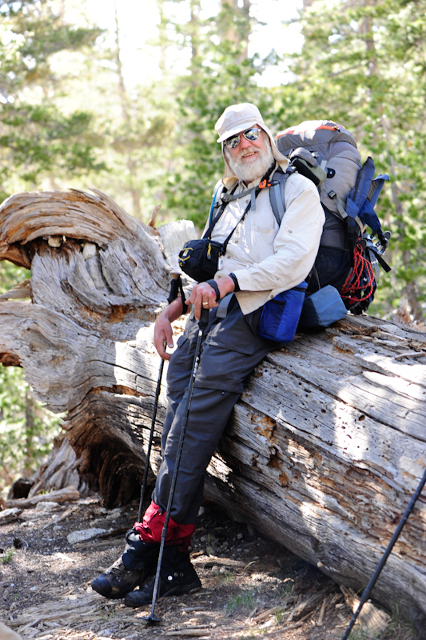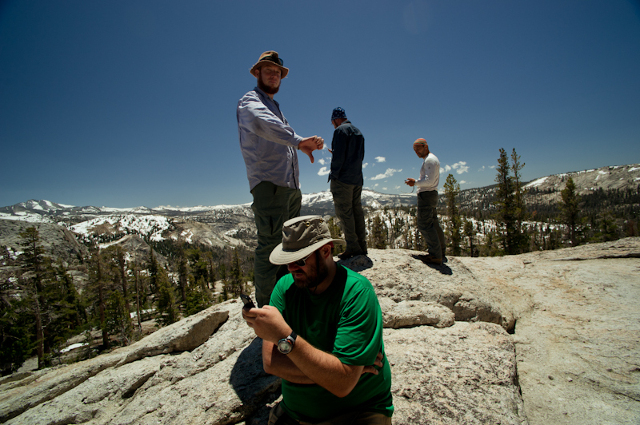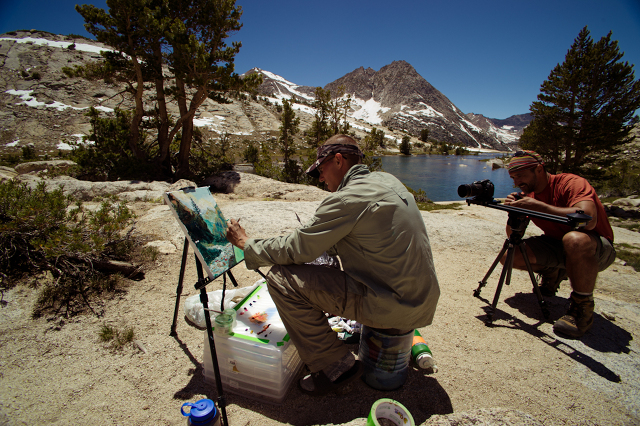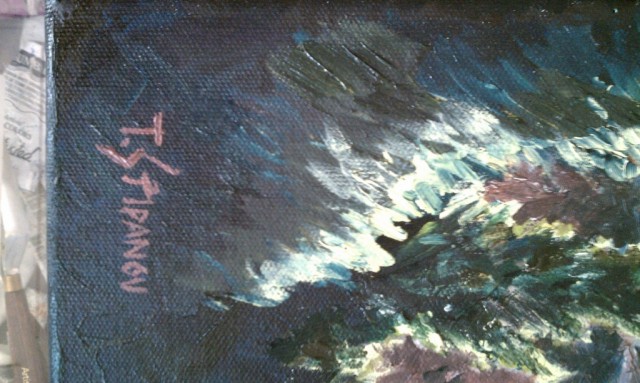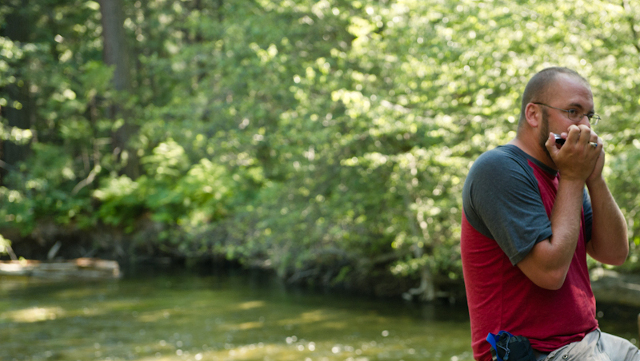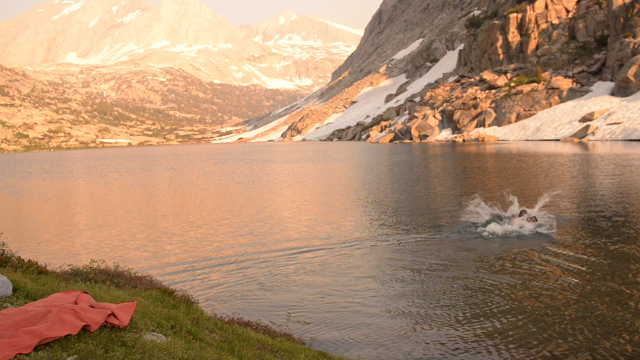HAPPY TRAILS
28 Nov
Your blog calls to mind a similar question my wife asked me the summer after we were married in 1991 and on her first and only backpack trip. We were panting up the switchbacks on the Ten Lakes Trail in Yosemite (we were married in the valley chapel the previous Fall). She asked: “And you call this fun?”
I responded (and I’m sure it’s accurate because I heard her repeat it over the years): “Fun? Who said anything about fun?”
I stand behind those sentiments. Fun is transitory gratification achieved with little effort. That is not backpacking. Backpacking is effort punctuated by rewards, anticipated and otherwise. The anticipated reward of a great view may be obscured in clouds, but the internal dialogue while ascending in the fog may reach conclusions that will reward in the future.
I must say I am surprised by my experience as a senior backpacker. I always assumed I’d have to quit by now, lending a sense of urgency to my my younger trips, but lightweight technology has added a few years to my hiking life. That and age hasn’t been the handicap I anticipated. Clearly I’ve lost speed, but stamina is not so bad, and I’m no longer as much under time pressure. {I would be remiss here if I did not sing the praises of the great god Motrin, without whose anti-inflammatory aid none of this would be possible}, Amen.
Happy Trails,
Ron
FOOT NOTE: We were lucky enough to meet up with Ron on the JMT at Cathedral Lakes
STARBUCKS PASS
10 Nov
It’s hard to choose just one special moment in what was really a special trip all around, but if I must I think I’m going to choose the top of “Starbucks Pass.” No there isn’t a pass named for the ubiquitous coffee chain, that’s just what the pass on the south side of Garnet Lake has been named in our lore.
The night before, we had come into camp in the dark after a really hard day trudging through snow over both Donahue and Thousand Islands passes. Then most of that morning, we had navigated some really treacherous snow banks around Emerald and Garnet lakes. The last kicker was an exhausting 300-foot climb straight up through the snow to get out of Garnet Lake’s basin. Once we finally reached the top of the ridge and could see the trail ahead, it was snow free. This was a huge relief because we were all pretty tired.
The other great thing was that unexpectedly we had great cell phone reception. We all took the opportunity to call friends and family and Ric and Jen got to talk to their daughter. As I looked at the group all chatting away on our phones, it reminded me of a Starbucks back home in LA, so it will forever live on in my mind as Starbucks Pass.
Footnote: The image is NOT from “Starbucks Pass” but one of the other moments when we had service, so we were all “checking in,” while The Captain gave his approval rating for service from his phone carrier. Guess who he had…
PLEIN AIR
3 Nov
Who cares about plein air?
Why do we paint outside en plein air? Why, for God’s sake, did we carry twenty two oil paintings two hundred and twenty miles through the Sierra Nevada?
Let’s take plein air for starters.
Some painters argue that, when painting outdoors, the colors are more vibrant and it’s easier to observe the details. Others say that capturing a place is more than what you see; you have to really feel the wind, the chirping of the birds, and the dusty ground.
I don’t buy that. Painting from a photograph boils a scene down to pixels, each with one hue, value and chroma. Outside, our eyes correct for dark and light areas, outdoor lighting alters the colors, and our inspiring environment is mainly conducive to blowing away our materials. Hands down, painting outdoors is way tougher.
That doesn’t matter. Art, more than producing an image or form, is the process of capturing an essence – a context that lends it meaning and is rooted in human experience.
Sure, the rules of aesthetics matter. Symmetry, complementary colors, and value contrast all contribute to our enjoyment of a piece. But a pretty image alone doesn’t cut it. Art viewers crave meaning. “Who is he?” “How did she make this?” “What is this trying to say?” That background creates the deeper pleasure associated with looking at great art.
We thoroughly experienced our subject, the Muir Trail, as we painted it, by carrying our artwork over passes, across rivers, through clouds, and up mountaintops. It nearly broke our backs.
Our paintings contain the essence of our creative process and our experiences on the trail. That essence is the art.
Plein air is the art. The journey is the art. The artist is the art.
We don’t leave the studio in quest of images. We seek art.
THE HARMONICA
28 Oct
The moment I was invited on the trek I had a thought, “I can finally learn the harmonica!”
It’s the perfect instrument for a hike; lightweight, pocket sized, simple, and the breathing required to play would help me adapt to the altitude. (You already know that last bit is going to come back to bite me, don’t you?) I mentioned my desire to Ric and the gang, along with one caveat- I’m tone deaf. (Which isn’t what it sounds like; I can hear the difference in tones, I just can’t necessarily recreate the difference in tones.)
No one blinked an eye. They were overwhelmingly encouraging (they’re a very positive lot.) Even with the endorsement from my would-be-victims I was hesitant. The worst case scenario played out in my head- driven mad by my noodling, the others would band together to shove my mouth organ down my throat and drown me in a mosquito infested lake. No court in the land would convict them. The less-worst case scenario involved the mouth organ drowning in the lake, and me left wondering where I misplaced it.
Buoyed by everyone’s support I ordered a decent harp, and anxiously awaited it’s arrival. I announced to the group that it was on it’s way… and they turned on me. Groaning, moaning, and cajoling about how I was going to make their ears bleed. Seems I’d done too good a job warning them of their impending doom.
It arrived a couple weeks before the hike, and lived in my pocket that entire time. I’d take it out to fiddle with here and there, taking it on my training hikes, showing it off with an ear to ear grin. A month in the wilderness would surely have me out as a master musician. It being my only entertainment, I’d perfect sweeping runs of the notes and chords, figure out how to put them together in song, and lead a rousing campfire rendition of “Row, Row, Row Your Boat” sometime before we left the territories where fires are permitted.
We hit the trail, and while the ribbing about my noodling continued, each of my companions took me aside to confide that they were, in truth, enjoying the sounds coming forth, even if they weren’t necessarily recognizable as song.
There wasn’t as much time to devote to it’s mastery as I’d hoped. There just weren’t enough hours in a day. I wasn’t good enough to enjoy playing with an audience (particularly a captive one) for more than a few minutes at a time, and my lungs never quite got to the point where playing at altitude was easy enough to do while slogging along.
My earlier assumption that all the breathing would help didn’t pan out exactly right. I should have been practicing much more before the trip (defeating the “I’m going to learn to play, on my own, in the mountains” theme) to prepare my lungs. It turns out that the thin air at altitude means you have to push that much more air to play.
I did manage to figure out how to play a song one day, when I had a good stretch of hiking without too much incline. But at this point, months later, I can’t recall what that song was, let alone how to play it. I’ll figure it out and let you know next time I hit the trail. It’ll be my constant companion on any future hikes, because even if I never learn how to play it, it is surprisingly uplifting to coax a smooth harmonious chord with no one to hear it but the marmots and the wind.
PS – The marmots don’t mind that I’m tone deaf.
JUMP
20 Oct
“No. Seriously. Jump. What’s wrong with you?! I’m going in. I don’t care that it’s raining or overcast. Ric doesn’t know it yet, but he’s going in (just remember to cover you ears when he goes in so his shrill high pitched screams don’t blow out your eardrums). I can’t smell, but I know just from looking at you that your odor is such that it brings tears to the eyes of those poor souls who must pass us on the trail. Exactly. You’re disgusting. When will you ever have the opportunity to do this again?!”
This last thought is perhaps the most compelling when it comes to deciding whether or not to take the fateful plunge. 3 months removed from the trail and my fondest memories of the hike are still the (almost daily) icy cold embrace of the crystal clear water of the Sierra’s…just barely beating out the care package I received from my younger brother halfway thru the hike which contained assorted chocolated nonsense and the most beautiful bottle of bourbon I have ever laid eyes on….I cannot stress enough how much a mid-trek care package can bring your spirits up, especially when it is addressed to “The Captain” in large black electrical tape and comes care of “Ogre”, but I digress…as I tend to do incessantly.
Almost 10 years ago, after moving to Los Angeles, good friends of mine introduced me to this god awful, yet exceptionally brilliant idea. No matter the circumstances, if you stop at a body of water, you must jump in it. It sounds crazy, I know, but truly the line between brilliance and insanity is a fine one. This idea has become my backpacking mantra and I encourage/enforce this thru time honored, psychological, peer pressure. What can I say? I’m essentially a grown up child sometimes. Sure, after resting for a few minutes and cooling down, that 45 degree snow melt lake doesn’t look quite as appealing as it did half an hour ago when you were sweating uncontrollably and begging any god who would listen for the slightest gust of refreshingly cool breeze, but this is a once in a lifetime experience. I have never had anyone backpacking with me who has regretted the experience in retrospect. How could you? It serves as both a bitterly refreshing bath and a truly soul shocking reminder that you are both alive and experiencing a place as few others do. Over the course of the John Muir Trail, a truly amazing journey, we jumped, dipped, dunked, and gracefully dove (not so much) into countless lakes, rivers, ponds, and creeks. It was remarkable.
I did not go in everyday, and for that I am regretful. Live without regrets and succeed where I have failed. I implore you all to jump into that pristine body of frigid water that you encounter next. I know. It’s cold outside and you’d rather just cook up that sodium brimming, dehydrated, masterpiece of a meal, but if you do it, I promise that you will not regret the experience…3 months removed.
